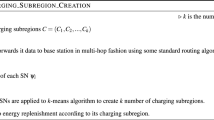Abstract
In a wireless sensor network, wireless Energy transfer is a demanding technology for the energy difficulties in recent times. The foremost disadvantage of presentation is limited duration because WSN contains only restricted battery energy at a node. Therefore, we anticipated cluster-related wireless energy transfer in this document. The foremost intention of the method is to augment the duration of the sensor network through charging by the help of this wireless power transfer technology. So that, mobile charging vehicle (MCV) is established to move within the network and charge the sensor node battery wireless. The sensor nodes in the network are collected as a cluster for energy efficiency. Here, the cluster head is chosen for each one cluster in the network which is based on the rank metric value. Suppose, if one node in the network is reducing its energy, then the CH will send charge request and route ID to the MCV. Afterward, the MCV recognize the node by means of the exacting route and establish to charge the node. The reproduction consequences illustrate that the network lifetime of our anticipated method is enhanced than obtainable method.















Similar content being viewed by others
References
Park, G., Rosing, T., Todd, M. D., Farrar, C. R., & Hodgkiss, W. (2008). Energy harvesting for structural health monitoring sensor networks. Journal of Infrastructure Systems, 14(1), 64–79.
Chang, J., & Tassiulas, L. (2004). Maximum lifetime routing in wireless sensor networks. IEEE/ACM Transactions on Networking, 12(4), 609–619.
Giridhar, A., & Kumar, P. R. (2005). Maximizing the functional lifetime of sensor networks. In Proceedings of ACM/IEEE international symposium on information processing in sensor networks (pp. 5–12). Los Angeles, CA.
Shi, Y., & Hou, Y. T. (2008). Theoretical results on base station movement problem for a sensor network. In Proceedings of IEEE INFOCOM (pp. 376–384). Phoenix, AZ.
Bulusu, N., & Jha, S. (Eds.). (2005). Wireless sensor networks: A systems perspective, Chapter 9. Norwood, MA: Artech House.
Jiang, X., Polastre, J., & Culler, D. (2005) Perpetual environmentally powered sensor networks. In Proceedings of ACM/IEEE international symposium on sensor networks (pp. 463–468). Los Angeles, CA.
Kansal, A., Hsu, J., Zahedi, S., & Srivastava, M. B. (2007). Power management in energy harvesting sensor networks. ACM Transactions on Embedded Computing Systems, 6(4), 32.
Liang, W., Ren, X., Jia, X., & Xu, X. (2013). Monitoring quality maximization through fair rate allocation in harvesting sensor networks. IEEE Transactions on Parallel and Distributed Systems, 24(09), 1827–1840.
Xie, L., Shi, Y., Hou, Y. T., Lou, W., & Sherali, H. D. (2013) On travelling path and related problems for a mobile station in a rechargeable sensor network. ACM Transactions MobiHoc’13, July 29–August 1, 2013.
Wang, C., Li, J., Ye, F., & Yang, Y. (2013). Multi-vehicle coordination for wireless energy replenishment in sensor networks. In IEEE Proc.
Peng, Y., Li, Z., Zhang, W., & Qiao, D. (2011). Prolonging sensor network lifetime through wireless charging. In Proceedings of IEEE RTSS, 2010.
Madhja, A., Nikoletseas, S., & Raptis, T. P. (2016). Hierarchical, collaborative wireless energy transfer in sensor networks with multiple mobile chargers. Computer Networks, 97, 98–112.
Xu, W., et al. (2016). Efficient scheduling of multiple mobile chargers for wireless sensor networks. IEEE Transactions on Vehicular Technology, 659, 7670–7683.
Xie, L., & Shi, Y. (2012). Multi-node wireless energy charging in sensor networks. IEEE Transactions, 23(2), 437–450.
Shi, L., et al. (2014). The dynamic routing algorithm for renewable wireless sensor networks with wireless power transfer. Computer Networks, 74, 34–52.
Lin, C., et al. (2016). Gtcharge: A game theoretical collaborative charging scheme for wireless rechargeable sensor networks. Journal of Systems and Software, 121, 88–104.
Author information
Authors and Affiliations
Corresponding author
Rights and permissions
About this article
Cite this article
Dhurgadevi, M., Meenakshi Devi, P. An Analysis of Energy Efficiency Improvement Through Wireless Energy Transfer in Wireless Sensor Network. Wireless Pers Commun 98, 3377–3391 (2018). https://doi.org/10.1007/s11277-017-5019-0
Published:
Issue Date:
DOI: https://doi.org/10.1007/s11277-017-5019-0




